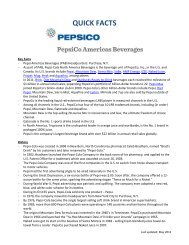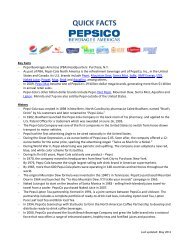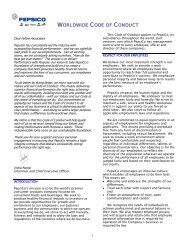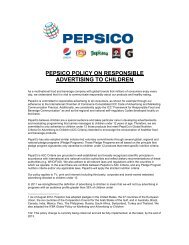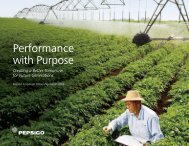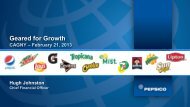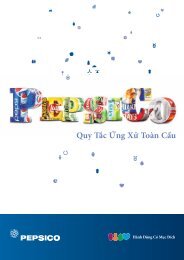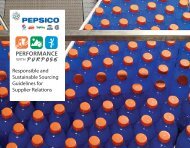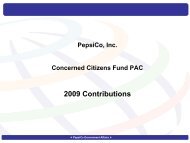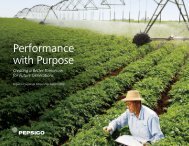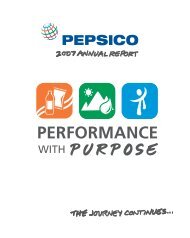Transcript - PepsiCo
Transcript - PepsiCo
Transcript - PepsiCo
Create successful ePaper yourself
Turn your PDF publications into a flip-book with our unique Google optimized e-Paper software.
FEBRUARY 23, 2012 / 3:30PM, PEP - <strong>PepsiCo</strong> at Consumer Analyst Group of New York Conferencethat many markets around the world, notably our fast growth markets like Russia, India, China and Turkey, our brand equity is improving year overyear. And when you have brand equity improving, it allows us to price through commodity costs that we have seen this past year.Now going forward, we want to continue to build on the success of these brands and we will increase our global A&M spending on snacks in 2012by over the %. And, of course, I will focus that investment against the biggest brands that matter the most, Lay's, Doritos's, Cheetos and Sun ships.Consistent with brand building we are also stepping up our innovation in 2012. I will give you just a few examples and I don't want to steal TomGreco's thunder, but on Lay's we will borrow from the success we had with the Walker's brand in the UK and Dubai's of flavor is now in over 20countries around the world.We will be rolling back into the U.S. leader this year. Doritos in the U.S. = we will be introducing our two biggest oldestand most intense products to date behind the launch of the Doritos Jack and the Doritos Dinamitas. Just a word of caution, before you go to lunchtoday, these are literally edible sticks of dynamite, so be careful and just so often people ask me or you ever going to do thanks other than just hot?Yes. We are borrowing from the success we have had in Europe behind Cheetos are we have moved Cheetos to play which is traditionally a saltysnack brand but it shows the strength of the brand that we can extend beyond salty two other occasions and we have introduced Cheetos Sweetos,that has done extremely well in European markets.Now to be fair, we have had a few markets around the world were in 2011 although globally we gained value share, there are a few markets wherewe didn't. Notably, here in the United States. We will be addressing the two segments within salty snacks and macro snacks that gave us someconcern and that is the premium segment and the value segment. All of [inaudible] potato chips and smart foods select are rolling into the U.S. aswe speak. And all the markets around the world are addressing the value segment, learning from the acquisition that we had from Lucky in Braziland the [Lahar] business we had in India and Tom Greco will talk about a great tasting, low-priced, unflavored tortilla chip called [Tacaros] that wewe're going to launch this year.Now beyond just the traditional salty snack Rams, we fairly quietly built a $425 million grain snack business. And in fact, grain snacks are one ofthe fastest growth platforms globally that we have and we fully expect it to grow double digits again this year in 2012. Grain snacks allow us tofind new occasions beyond traditional snacking and enter into many mills and grain snacks allow us to serve additional cohorts like many of us inthis room, aging baby boomers.Now as you know, we are able to penetrate markets with our innovation, with speed and granularity, leveraging multiple go to market systems,the most famous of which is our direct store delivery systems around the world. And in fast growth markets like Russia and Brazil, we do co-minglesnacks and beverages together on the same assets. And that enables greater reach and lower cost. And in all markets developing and emergingwe are able to leverage the back office so that we have the lowest possible cost structure and we leverage best practices like revenue management.You know, and finally, something that I am personally passionate about is that given the fact that we are seed-to-shelf in macro snacks around theworld, that to me is an endless opportunity for productivity and we are constantly looking to raise the hurdle rate in terms of productivity levelsthat we are looking for. And in 2012 we have ramped up our productivity levels to the point that it is largely enabling us to afford that increasedA&M investment that we're making.So I think when you take this together, I hope you feel that we are continued well positioned to continue our leadership in macro snacks andnotably, savory snacks.The market is large and growing.We are the undisputed share leader.We have a proven history of brand building, innovation,execution and a relentless focus on productivity. And combined we know that we can continue to grow volume and revenue and our expectationis to continue to grow value share globally.Now importantly, we have spent the past decade building our snack businesses around the world. And in 2011 our international revenues passedthe revenues of Frito-Lay North America. And that is not to take anything away from Frito-Lay North America, because I would argue that Frito-LayAmerica had an outstanding 2011.We grew volume 1%, we grew revenues 4%, and we grew profits 7%. And importantly during the course of theyear as we sequentially priced each quarter to cover fully our commodity costs and the inflation in our total business, we maintained that 1%volume growth. And I think when you benchmark to volume growth of Frito-Lay versus most other food and beverage companies, you will findout that that is industry-leading. It's food and beverage overall decline 1.5% in the fourth quarter.THOMSON REUTERS STREETEVENTS | www.streetevents.com | Contact Us3©2012 Thomson Reuters. All rights reserved. Republication or redistribution of Thomson Reuters content, including by framing or similar means, is prohibited withoutthe prior written consent of Thomson Reuters. 'Thomson Reuters' and the Thomson Reuters logo are registered trademarks of Thomson Reuters and its affiliatedcompanies.
FEBRUARY 23, 2012 / 3:30PM, PEP - <strong>PepsiCo</strong> at Consumer Analyst Group of New York ConferenceNow, you can believe me or you can believe Tom Greco. And so I am happy today to have with us our new president of Frito-Lay North America,Tom Greco. Tom is a 25-year veteran of <strong>PepsiCo</strong>. He and I have worked together for many years. He ran the Canadian business for us. He led thedirect store delivery system for Frito-Lay North America. He has worked in our beverage business for the past four or five years. He is a proven leaderand I know he and his team will continue to take Frito-Lay to accelerated heights.With that,Tom Greco.Tom Greco - <strong>PepsiCo</strong>Thanks, John and good morning, everyone. It's great to be here to tell you how optimistic that I am about the growth prospects for Frito-Lay NorthAmerica. As John mentioned, we had a strong 2011. We operate from a position of strength with decided competitive advantages. This is a resultof a relentless focus on developing differentiated products, building our brands, and leveraging an advantaged go to market system. It was nodifferent in 2011.We're the proud owners of four of the top of the food brands in the U.S. -- Lay's, Doritos, Tostitos, and Cheetos. Finally we'd are the market shareleader in North America within the broader macro snack segment.The macro snack universe is a great place to be within the North American foodand beverage landscape. It's a $102 billion category in which we have just under a 14 market share. Many of our new products compete withcategories and brands outside of the traditional salty snack category, which gives us plenty of room to grow.This is good news for Frito-Lay as themacro snacks category has been growing faster than overall food and beverage in recent years.This was true as well in 2011 as represented by theyellow bar.However, there is a trend developing which is requiring us to think very differently and John touched on earlier.The American macro snack consumeris truly bifurcating. As a result there's rapid growth as both premium and value segments within macro snacks.We continue to hold a strong shareposition in the mainstream segment and we have increased our presence in premium behind the Stacy's brand.However, we did not gain market share in the segment in 2011.We are maniacally focused on gaining share in all three of these segments in 2012.I will explain how shortly. Our blueprint for growth has four primary chat or switch are aligned with John's global snack platforms.First, brand building.We're I will outline our plans to invest incremental A&M behind our big brands.Secondly, innovation, where we have a lineup of the most powerful innovation we have had in at least five years.Third, execution. We're not only strengthening our world-class DSD system, but we are breaking new ground in food service and we are fullyleveraging <strong>PepsiCo</strong>'s warehouse delivery system.And finally, productivity, which is a hallmark for Frito-Lay over the years and a territory where we have actually ramped up to that he significantlyin 2012, on disciplined march to deliver 4% productivity on our compressible cost base.Allow me to walk you through our plans, beginning with brand building. In an effort to unlock growth and accelerate our brand building efforts,we have developed a consumer demand framework that helps identify white space in the broader $102 billion macro snack category. It has givenus a roadmap on how to accelerate growth on our iconic brands. Each one of these demand segments is driven by occasions that allow one of ourbrands to own that particular segment.We're incredibly clear on what drives growth and consumption in each segment. Let me bring one of thesedemand segments to life.The consumer we know of actually as the snack fanatic. The snack fanatic segment is nearly a $14 billion macro snacks they. The segment SKUsmales 25 and younger and they love to snack and they snack all day long. Their preferred snacks tend to be personal statements about who theyare and what they love. For Frito-Lay, the space aligns perfectly with one of our iconic brands, Doritos. Snack fanatics are looking for brands tofacilitate the expression of who they are, but putting the brand in their control. The Doritos brand has captured this insight and has turned toconsumers to generate Super Bowl advertising. It gives consumers the chance to be heard and discover on the world's largest age and it helpsbuild the Doritos brand as consumers celebrate their distinctive passion for the brand. Let's take a look at two spots that aired in this year's SuperBowl, entitled "Man's Best Friend" and "Sling Baby."THOMSON REUTERS STREETEVENTS | www.streetevents.com | Contact Us4©2012 Thomson Reuters. All rights reserved. Republication or redistribution of Thomson Reuters content, including by framing or similar means, is prohibited withoutthe prior written consent of Thomson Reuters. 'Thomson Reuters' and the Thomson Reuters logo are registered trademarks of Thomson Reuters and its affiliatedcompanies.
FEBRUARY 23, 2012 / 3:30PM, PEP - <strong>PepsiCo</strong> at Consumer Analyst Group of New York Conference[video playing]Tom Greco - <strong>PepsiCo</strong>You know I asked the guy who produced "Man's Best Friend" how did you get that dog to hold that bag of Doritos in his mouth and he said, "Wewent through a lot of Doritos." You know, the commercial still only cost $22 so you have got to love the Doritos consumer.The Super Bowl results that we had this year were unprecedented and really record setting for the industry. "Man's Best Friend" scored numberone in the panel-based USA Today ad meter. But the real driver of this effort is the online and social buzz this program created. It's no surprise thatthe reader was also won the first-ever online Facebook ad meter as well with the "Sling Baby" spot. AC Nielsen also reported that Doritos was themost open about and most-liked advertising in the Super Bowl. Brand Bowl also ranked Doritos as the the number one brand in the Super Bowlwith the most recall of any spots. As a result our year-to-date performance on Doritos our scans, are up double digits.That is what owning andmastering the snack fanatic segment is all about.It's this approach to brand building that we are undertaking for Frito-Lay's mega-brands. We're increasing A&M by 35% by understanding theunique demand segment each brand plays in.We are increasing our share of voice to gain market share within macro snacks.While we're very excited about our brand building plans in 2012, we are equally excited about our deep innovation. Frito-Lay has a great trackrecord on innovation. Our 2012 innovation pipeline is absolutely loaded and very incremental. Some highlights include Doritos Jacked, the ultimatebigger, bolder crunch. John talked about Doritos Diminita. Diminita significantly preferred to our major competitor in consumer taste-testingamong competitive users in the critical Southern California market. Ruffles Ultimate, the new original potato chip with thicker cut and deeper ridgesthat are full of great Ruffles flavor. Russell Smokehouse style barbecue, inspired from the winning recipe at the world they miss Memphis in Maybarbecue competition. Lay's kettle cooked reduced fat -- 40% less fat than regular potato chips. And finally, new flavors on Tostitos Artisan.TostitosArtisans are made with all-natural ingredients like black beans, garlic, chipotle peppers and spices that you can see and taste in the chip. Theseproducts are inspired by culinary recipes developed by Frito-Lay chefs.We also have a big opportunity to innovate and partner our snack and beverage brands together. The max brand is a great example of this. PepsiMax is a brand that is all about maximum taste with 0 calories. It's targeted to young males and as you know, for young males, taste is king. Rufflestargets the exact same consumer with what we call "dude food on a chip." This is a product experience about maximum taste. So we tested aproposition that unites Pepsi Max and Ruffles Max and we found a great opportunity, as 50% of Pepsi Max consumers are also consumers of Ruffles.You'll see this great combination in the back half of this year.Now recognizing the need to innovate beyond mainstream with the rapidly growing value and premium segments, Frito-Lay established growthventures. Growth ventures is an entrepreneurial division that operates with a company-within-a-company mindset.The mission is to build a highlyincremental multibillion-dollar snack business via a dedicated, niche brand portfolio. The agile operating model of growth ventures leveragesmainstream Frito-Lay capabilities while focusing on differentiated offerings to both value and premium consumers. The premium segment is arapidly growing $2 billion opportunity within salty snacks alone. This was the initial focus of growth ventures. Growth ventures has acceleratedour innovation in 2012 to compete or vigorously in the premium segment.One example is the lineup of snacks under the smart food selects Dan or that will be merchandised outside of our traditional gondola and nearother premium snacks. The portfolio offers premium herbs and spices on forms like pop corn, puffed corn, chips and granola popcorn. We areexcited about our lineup in the premium segment, including a great idea from South America called Twistos, which we recently formulated andlaunched in Canada in the fourth quarter. The value segment is a $2.7 billion opportunity and salty snacks alone. In the coming months growthventures will launch a portfolio of value popcorn innovation under the Crackerjack rant as well as a highly differentiated authentic value towardthe edge of hundreds of Taqueros Del Sur brand name in select value-oriented channels and stores.These attractive price per pound offerings willbe complemented by options that offer great opening price points.One area in which we are laser-focused on innovation at the opening race point is Lay's Stax. Lay's Stax has a strong type line of innovative newflavors, including a terrific targeted line of Hispanic flavors. These products build on the rich knowledge and success that we have in our SabritasTHOMSON REUTERS STREETEVENTS | www.streetevents.com | Contact Us5©2012 Thomson Reuters. All rights reserved. Republication or redistribution of Thomson Reuters content, including by framing or similar means, is prohibited withoutthe prior written consent of Thomson Reuters. 'Thomson Reuters' and the Thomson Reuters logo are registered trademarks of Thomson Reuters and its affiliatedcompanies.
FEBRUARY 23, 2012 / 3:30PM, PEP - <strong>PepsiCo</strong> at Consumer Analyst Group of New York Conferencebusiness in Mexico. And Lay's Stax is very well positioned within the Stax PC segment. In 2011 Stax grew 9% and the brand is off to a blistering startin 2012, growing 40% year-to-date while our competitor declined. And importantly, Lay's is growing household penetration.In the past three years Pringle's sales have declined 1.5% per year and they have lost a 0.5 point of market share within the salty snack segment.Bottom line, we are energized about our growth plans on Lays Stax and see significant volume and share upside with this product. In total, we'veseen the brands from growth ventures grow more than 20% annually in measured channels since 2008. Now that we are managing them as acollective portfolio which shared resources we expect this growth to accelerate in the coming years. Growth ventures will deliver a significantportion of Frito-Lay's growth in the future. In fact we expect to contribute two full points of net sales growth in 2015.Now let's talk execution.You know, go to market is all about selling ordering the liver in and merchandising and our multiple go to market solutionsprovide unmatched service in the CPG industry.The majority of our business is classic DSD, as most of you know where we have over 18,000 routethat make over 500,000 weekly service calls on over 280,000 customers. To service customers and products that are a better fit for warehousedelivery we're leveraging <strong>PepsiCo</strong>'s warehouse delivery infrastructure. Finally we have a go to market solution with the unique [price-sized]architecture for our food service vend customers through our distributor partners. And John will talk to you about an exciting product we arelaunching in food service and a few moments.Our direct store delivery system gives Frito-Lay the capability to customize product assortment to the channel and consumer we serve.This allowsfor dynamic product customization and innovation that meets the needs of consumers. A great example of this is our "choose any two" offeringhere in a Sam's Club which provide strong value and a flexible assortment of Frito-Lay snacks. To drive immediate consumption we leveragedSobritas in Mexico to launch new products in New York City, Los Angeles, and many other urban cities. In 2011, these urban markets grew at anaccelerated rate and we have plans to sustain that momentum into 2012.Localization is an important component in exceeding special geographic and summer needs.We're constantly leveraging local knowledge to giveour customers locally relevant varieties of their favorite Frito-Lay brands. I know many of you are familiar with GES. GES is a critical unlock for futuregrowth, productivity, and speed to market at Frito-Lay.With GES, we eliminate redundant distribution Center inventory and we leverage best-of-bestbest material handling automation to pick store level orders back at the manufacturing plant.This gives Frito-Lay unmatched DSD capabilities.Weremain on track to complete deployment of GES.Our productivity agenda is more robust than ever, and will reduce operating costs and support our growth through reinvestment in our brands.In addition to the tremendous go to market advantage we see as we ramp up GES, our manufacturing automation program gives us a uniqueopportunity to reduce costs while improving product value. By removing touches on each bag we not only realize labor savings, that we also helpdeliver improved quality at the shelf.So let me -- allow me too summarize our plans for Frito-Lay North America. A significant step up in A&M in 2012, our most incremental lineup ofinnovation in several years, a relentless focus on execution across multiple go to market systems and a powerful productivity program designedto remove waste. We expect that this will yield low single digit volume growth and translate to mid single digit revenue growth. Frito-Lay is anamazing organization. We have an unquestionably advantage portfolio of brands and a perpetual focus on invention, driving innovation andsustaining our pricing. Our world-class operation has unmatched distribution capabilities and going forward, we will elevate our intensity onproductivity. It's an exciting agenda indeed. And now allow me to turn the podium back over to John Compton to talk to you about One <strong>PepsiCo</strong>.John?John Compton - <strong>PepsiCo</strong> - CEOSo let me wrap up today and get a little focus on what we are doing to bring our snack and beverage brands together and hopefully you will seethat this is a differentiated approach going forward and not just the same we have done in the last ten or 15 years.You know, it's a simple fact that consumers think about our beverage and snack brands together.When she makes her list, she plans them together.When she goes to the store, she buys them together. And when she's home, she celebrates them together with her family. So to us, having snacksand beverages together in the same company clearly makes consumer sense as much as it does shareholder sense.THOMSON REUTERS STREETEVENTS | www.streetevents.com | Contact Us6©2012 Thomson Reuters. All rights reserved. Republication or redistribution of Thomson Reuters content, including by framing or similar means, is prohibited withoutthe prior written consent of Thomson Reuters. 'Thomson Reuters' and the Thomson Reuters logo are registered trademarks of Thomson Reuters and its affiliatedcompanies.
FEBRUARY 23, 2012 / 3:30PM, PEP - <strong>PepsiCo</strong> at Consumer Analyst Group of New York ConferenceNow snacks and beverages as you know are often the largest categories in a store --we're either number one, number two or number three. Andbuyers of just carbonated soft drinks and snacks, those two products are bought together 30% of the time, generating $12 billion of revenue. Andretailers asked us consistently to increase that co-purchase. Why? Because of the margin and cash flow generated. And since we are number onein LRB north number one in salty snacks of course, they turn to <strong>PepsiCo</strong> to solve this riddle. Every point that we convert is worth $120 million to usand it's something we are maniacally focused against.Now as you know, we have been talking about power of one for some time, arguably about 13 years. But this idea was foundational when HermanLay and Don Kendall put the company together. And over the past 13 years we built customer teams, we've established perfect pairs for pricepromotion and we have done those occasional big holiday promotions. In all of this we'll remain in its foundational to what we do, but we thinkwe unlock the bigger idea.We took a step act and we started with a fairly basic question. How can we create a consumer identity across two of the largest brands in the world?In other words, is there a way to create an identity about which consumers would think of the brands together every day of the year, not just fouror five big promotional timeframes? Well if you happen to go to Indianapolis for the Super Bowl, you saw it in full force. We launched our identityjust in time. It's a series of streamers that originate from the brands to bring together the celebration of what these two brands can do it together.In this case, creating a great football experience.We'll be using this branding across our brands across multiple occasions, birthday parties, but all,whatever that may be. Different cohorts -- Hispanic versus boomers. And we will be launching an integrated media campaign this summer, digitaland outdoor billboards.We've standardized a toolkit for our sales teams all across the country, 72 hours point click and shoot in the store, customizedto that local market, using these identities. And beginning early summer this identity will be unavoidable. It will be on our permanent equipment.It will be on our temporary equipment. And it will be, as I said in the media and the marketplace.We think the identity allows us to bring togetherthe co- purchase of these brands and maintain the uniqueness of each individual brand. This is an idea that doesn't play just in retail. We thinkthere's a big application and food service.As many of you know, food service accounts are often big jump balls between two big companies like Pepsi and our competitor.That increasinglyfood-service is turning to us to help them build out their food service offering through food, like Doritos and Lay's and Quaker oatmeal. Case inpoint,Taco Bell.Now, you know that Taco Bell has been a terrific beverage partner of ours for many years and Taco Bell came to us and said our consumer is thesame as your Doritos consumer. Surely there's a way that we can come together and create a branded product in store. Doritos Loco's Tacos arerolling nationally right now. It's a huge idea. It's a taco that plays off the great taste experience the crunch of a Dorito with that great Dorito nachocheese taste and it's complete with that the messy orange stuff on your fingers, too, OK? It's launching nationally. Taco Bell thinks it may be oneof their biggest ideas for 2012, and I'll share with you quickly just a 15-second teaser ad that they just launched on American Idol, where one of ourcompetitors happens to be sometimes. And here is the ad that just ran.[video playing]John Compton - <strong>PepsiCo</strong> - CEOThat's a big idea. And there's many other ideas like that that we are working on.Now finally, beyond retail and food service, we do recognize the consumer remains cash craps. We are aware that gasoline prices could be $4 or$5 this summer and by leveraging the scale of our portfolio through this common identity will be launching [$100] of value during the course ofthe year to bring together our brands uniquely and remind her that <strong>PepsiCo</strong> brands uniquely can help her in a pretty tough environment rightnow.So, I hope you can take away today that we have a solid foundation from which to build and extend our undisputed leadership in macro snacks,that our global snack leadership in part is led by a continued successful Frito-Lay North American business that is increasingly learning from othermarkets around the world. And that we finally have a unique opportunity to brand, not price promote, brand, our beverage and snack rants togetherTHOMSON REUTERS STREETEVENTS | www.streetevents.com | Contact Us7©2012 Thomson Reuters. All rights reserved. Republication or redistribution of Thomson Reuters content, including by framing or similar means, is prohibited withoutthe prior written consent of Thomson Reuters. 'Thomson Reuters' and the Thomson Reuters logo are registered trademarks of Thomson Reuters and its affiliatedcompanies.
FEBRUARY 23, 2012 / 3:30PM, PEP - <strong>PepsiCo</strong> at Consumer Analyst Group of New York Conferencegiving us a competitive advantage with shoppers when they make their purchase decisions. And with that, we are happy to take your questions.Judy?QUESTIONS AND ANSWERSUnidentified Audience MemberJohn or Tom, just in terms of looking at different segments, a premium segment and the value segment within salty snacks, so it sounds like thegrowth in those segments are much faster than sort of the mainstream segment. Can you quantify how the growth you are seeing in each of thosesegments and as those segments get bigger and you focus on those segments, how do you ensure that the mainstream can continue to grow andyou get your fair share of that segment?John Compton - <strong>PepsiCo</strong> - CEOI'll let Tom take the question and then I'll come back to it.Tom Greco - <strong>PepsiCo</strong>Obviously, the premium segment is growing the fastest of the three and the value second, and then mainstream. As we enter those categories wemanage a portfolio of brands. Our overall portfolio has differential upsides, whether it's volume upside or margin upside in our business. So welook at the opportunity in each of those segments in that respect.We look for things that are fast-growing segments that we can compete vigorouslyin, and over time, ensuring that our margins are comparable to our overall margins. So, we are very aggressive in both premium and value in 2012,more than we have ever been and we expect to gain market share in both the segments this year.John Compton - <strong>PepsiCo</strong> - CEOI think, Judy, to be fair, we are obviously a little more comfortable in the premium segment. We have been there with Stacy's, we've been therewith Sombra, et cetera. The [unlock] for Frito-Lay is growth ventures company--within-a-company concept. We are able to leverage a different goto market system to launch these products. And therefore we are able to compete on a margin basis pretty successfully also in that low-end segmentthrough the value offerings. Questions? Caroline?Unidentified Audience MemberHi. Just a couple of things in terms of the margin impact going into value. And it's something you have never done before, so it is I think meaningfuleven if it starts out small. Can you start with that?Tom Greco - <strong>PepsiCo</strong>Again, when you take the P&L apart, you know that our DSD go to market systems come with a lot of benefits and it also comes with cost. Theseproducts will not be going through DSD, so that cost component of the P&L we will put that in product and price. And so the margin, frankly, isnot that much different than some of the other margins we have in other DSD systems.We sell Santitas, we sell products like that, that are in there.So the mix of margins, we are aware of how they will move and toggle throughout the year but we are fine with it. So the go to market system isthe unlock.THOMSON REUTERS STREETEVENTS | www.streetevents.com | Contact Us8©2012 Thomson Reuters. All rights reserved. Republication or redistribution of Thomson Reuters content, including by framing or similar means, is prohibited withoutthe prior written consent of Thomson Reuters. 'Thomson Reuters' and the Thomson Reuters logo are registered trademarks of Thomson Reuters and its affiliatedcompanies.
FEBRUARY 23, 2012 / 3:30PM, PEP - <strong>PepsiCo</strong> at Consumer Analyst Group of New York ConferenceUnidentified Audience MemberOK, the other thing I wanted to understand is the Power of One and it should have. Do you need to own your manufacturing and distribution inbeverage in order to leverage that, or, you know, it sounds like from your last meeting if return on assets doesn't improve their pretty soon, youmight look at a different structure for the ownership of that business. So how does that tie in with work on the Power of One?Indra Nooyi - <strong>PepsiCo</strong> - Chairman and CEOWe don't need to own it, Caroline, but it's-- I think the beverage business should want to partner with snacks because we're so strong in the snackbusiness. So, whatever we do with the beverage business, I think leveraging this common identity is a good idea to drive growth in both places.John Compton - <strong>PepsiCo</strong> - CEOAnd to build on Indra's point, by channel, it's different.The size of the beverage business and snack business in grocery stores is roughly the samesize.The convenience stores and so therefore to Indra's point, the beverage business could leverage the Frito-Lay business. In convenience stores,the reverse is true.The beverage business is almost five times larger, so the snack is this benefit from leveraging the business there. Brian?Unidentified Audience MemberThanks. So, first, in terms of the increase in A&M spending just so we are clear, A&M spending does or does not include price promotions andpromotions?John Compton - <strong>PepsiCo</strong> - CEONo.Tom Greco - <strong>PepsiCo</strong>No.Unidentified Audience MemberOK. And then in terms of Lay's Stax and the comment about opening price point, does it mean having to adjust the current price point from whereit is? Are you going to adjust the price down or is it already at an opening price points?Tom Greco - <strong>PepsiCo</strong>It's already at an opening price point, so we are happy with the price-value relationship with our competitor there. And we really see innovationplaying a big role for us as we—and our go to market flexibility in helping us advance our share position within that segment.Unidentified Audience MemberOK, and just one final thing -- as you flex more into value segment, I guess it was noticeable that potato chips were not part of the strategy, and Ialways had the impression that that was sort of the lowest cost, where you had a big competitive advantage on cost. Is that—THOMSON REUTERS STREETEVENTS | www.streetevents.com | Contact Us9©2012 Thomson Reuters. All rights reserved. Republication or redistribution of Thomson Reuters content, including by framing or similar means, is prohibited withoutthe prior written consent of Thomson Reuters. 'Thomson Reuters' and the Thomson Reuters logo are registered trademarks of Thomson Reuters and its affiliatedcompanies.
FEBRUARY 23, 2012 / 3:30PM, PEP - <strong>PepsiCo</strong> at Consumer Analyst Group of New York ConferenceJohn Compton - <strong>PepsiCo</strong> - CEOYeah, remember, we have multiple offerings within potato chips already today. So we have regular Lay's, we have Lay's Kettle, that's more premium,we have Ruffles, that's also somewhat premium.Regular Lay's sells basically on average with the market. We don't go all the way down to private label pricing, but we don't charge a significantpremium with regular Lay's.Unidentified Audience MemberThank you.Indra Nooyi - <strong>PepsiCo</strong> - Chairman and CEOKeep in mind, that when you talk about value and premium you are not talking about an either/or.You are talking about growing the mainstream,growing premium and growing value. So, you're talking about growing all of the segments. So back to your question, Caroline, this is growingevery aspect of the business because last year as John and Tom mentioned, some of the value competitors and premium competitors of those thattook share from us, our mainstream also grew. So the idea is today diversify our offering, so you go after each aspect of the business withoutharming the mainstream. You want to protect the mainstream that goes through DSD and go up to premium and value in a different, [shaded]way.That's why we have different brands, different products in those spaces.Tom Greco - <strong>PepsiCo</strong>I'd like to just add, John, that the A&M step up is largely on our core brands within mainstream, so-- including Lay's. So the intention there, back toI guess Judy's question, I mean, that goal is to expand the mainstream brands within the broader macro snack landscape. So, we're trying to getafter that $100 billion dollar sandbox versus the narrower $20 billion salty snack space.Unidentified Audience MemberCan you just talk about U.S. pricing environment in both businesses and how you think things have changed in the last three weeks and kind ofwhat your outlook is for the rest of the year? And then also can you give more color on the timetable for the U.S. DSD decision, like what themilestones and when you are ultimately going to tell us what's going to happen with that business?Tom Greco - <strong>PepsiCo</strong>I will take the pricing question and then come back to the DSD question. What we have said is we've largely taken the pricing that we needed totake. For certain, in the snack business, we have fully priced through our inflation cost and otherwise. And we remain open to what happens for2013 commodity outlooks and we will address that in the fourth quarter this year.Indra, on the DSD? Or Hugh?Hugh Johnston - <strong>PepsiCo</strong> - CFOI will take care of that.What we said before, if you recall back in the meeting about 10 days ago, was we were looking at three things.THOMSON REUTERS STREETEVENTS | www.streetevents.com | Contact Us10©2012 Thomson Reuters. All rights reserved. Republication or redistribution of Thomson Reuters content, including by framing or similar means, is prohibited withoutthe prior written consent of Thomson Reuters. 'Thomson Reuters' and the Thomson Reuters logo are registered trademarks of Thomson Reuters and its affiliatedcompanies.
FEBRUARY 23, 2012 / 3:30PM, PEP - <strong>PepsiCo</strong> at Consumer Analyst Group of New York ConferenceNumber one, hold or grow value share. Number two, pathway to profitable growth, and number three, with [add] return on invested capital. Andwe said we needed to see the pathway to that in 12 to 18, months, so that timeframe has not changed. We need to see that pathway in 12 to 18months.Unidentified Audience MemberSo, will there be constant updates, or are we going to wait 12 to 18 months for the decision?Hugh Johnston - <strong>PepsiCo</strong> - CFOWell, I think in terms of terms of the constant update piece, you will see the value share. You will see the profitability, because it's disclosed andyou will see the ROICs, because we give you the asset base. So, we talk about it as we disclose the quarter, but we will see the information just thesame as we will.Unidentified Audience MemberAnd just on the beverage side of pricing?Tom Greco - <strong>PepsiCo</strong>It's consistent with what I've said about the snack business.We've largely taken it to date.Unidentified Audience MemberGreat.Thank you.Tom Greco - <strong>PepsiCo</strong>John?Unidentified Audience MemberThanks. Just a quick follow-up, actually, on Bill's, about the pricing. So, the one difference, though, right, is you're pricing to cover all cost inflationon Frito but you are not pricing to cover all the cost inflation on beverages? Is that what you are saying?Tom Greco - <strong>PepsiCo</strong>Fair statement.Unidentified Audience MemberOK. And it's rollover pricing from fourth quarter of last year?THOMSON REUTERS STREETEVENTS | www.streetevents.com | Contact Us11©2012 Thomson Reuters. All rights reserved. Republication or redistribution of Thomson Reuters content, including by framing or similar means, is prohibited withoutthe prior written consent of Thomson Reuters. 'Thomson Reuters' and the Thomson Reuters logo are registered trademarks of Thomson Reuters and its affiliatedcompanies.
FEBRUARY 23, 2012 / 3:30PM, PEP - <strong>PepsiCo</strong> at Consumer Analyst Group of New York ConferenceTom Greco - <strong>PepsiCo</strong>That's correct.John Compton - <strong>PepsiCo</strong> - CEOThat's correct.Unidentified Audience MemberOK. You know, following up again -- I hate to sort of pick on this continued sort of decision process, but when you talk about your value sharetargets in beverages it's on a total LRB basis, right? So as I look at your DSD organization if you are growing share in Trop and Gatorade which issort of out of the bottler network, but let's say you're continuing to lose share in CSDs, you know, I am just trying to figure out how your decisionon that route to market will work within the construct of how you are looking at LRB shares within segments?Indra Nooyi - <strong>PepsiCo</strong> - Chairman and CEOJohn, we've played the LRB game, have been playing it for-- Gatorade still goes to DSD in small formats. Tropicana is a tiny piece of the wholepuzzle. We are going to look at total LKRB share. That's the game we play. The CSDs have become smaller for the marketplace. The rest of thenon-carbs have been growing faster, so we will continue to look at value share in total.Total LRB.Unidentified Audience MemberI guess if the conscious decision is to sort of cede value share within your DSD businesses, isn't that sort of a fait accompli?Indra Nooyi - <strong>PepsiCo</strong> - Chairman and CEO80% of the business is going through DSD, so we don't put value share overall. DSD value share has to grow.Think about it.Tropicana and large-formatGatorade is the only one that goes through warehouse. Everything else goes through DSD.Tom Greco - <strong>PepsiCo</strong>Right here. Right behind you.Unidentified Audience MemberHi, Tom or John -- [any] margin structure is the envy of the food industry and you have been able to expand it the last couple of years despite thecommodity pressure. So can you talk about your ability, longer term, to continue to expand margins in North America and if there is a certain pointyou think-- that level?John Compton - <strong>PepsiCo</strong> - CEOI'll take that, and maybe Tom can add on.You know, remember being at CAGNY many times, we had a period of time where we were not growing margin at Frito-Lay. Margins were roughlyflat. And we don't need to expand margins 100 basis points a year in that business. If we get mid single-digit revenue our expectation is turn thatTHOMSON REUTERS STREETEVENTS | www.streetevents.com | Contact Us12©2012 Thomson Reuters. All rights reserved. Republication or redistribution of Thomson Reuters content, including by framing or similar means, is prohibited withoutthe prior written consent of Thomson Reuters. 'Thomson Reuters' and the Thomson Reuters logo are registered trademarks of Thomson Reuters and its affiliatedcompanies.
FEBRUARY 23, 2012 / 3:30PM, PEP - <strong>PepsiCo</strong> at Consumer Analyst Group of New York Conferenceinto mid single-digit profit growth. So, 20 or 30 basis points a year, I think, in Frito-Lay, would be fine. It's not one or one and a half points per year.You might have an opportunity where that happens. You also have situations sometimes when margins are flat to slightly down. But ongoing, 20to 30 basis points.Unidentified Audience MemberAnd the GES productivity program, should that really ramp up your productivity longer term? Or are there some other productivity initiatives you'vehad, that ramped down, so you were not see a big step change there?John Compton - <strong>PepsiCo</strong> - CEOI think we would say GES is the single biggest unlock we have on both productivity and accelerating revenue. And 2012 is the year where we hadto take a little bit of a timeout to get all the SAP interfaces in place and then we're back on schedule, 2013, going forward. But we will convert threeto four markets a year. It's a massive change all the way back from the manufacturing plant through to the shelves.Tom Greco - <strong>PepsiCo</strong>Yeah, I would add in addition to GES, we have a couple of transformational productivity initiatives that are out there. The automation in ourpackaging room is a big one. The customer enterprise solutions that we have in terms of our route to market. And go to market solutions. Thedifference with our productivity then to now is we really have transformational changes in addition to the things we have been noted for historicallywhich includes lean Six Sigma, black belts, kaisan leaders, all those things that are just ongoing and frankly pervasive throughout the entire Frito-Layenterprise. Question?Unidentified Audience MemberIndra or Hugh, I was wondering if you could kind of a compare and contrast for us? If you think about the reset to some extent has been alreadybeen achieved for Gatorade versus, say, three years ago.What from that experience do you think is applicable to the reset that has begun for yourcarbonated business and what do you think is unique to the carbonated challenges that you are going to be doing differently and looking for thoseimproved carbonated share trends?Indra Nooyi - <strong>PepsiCo</strong> - Chairman and CEOWe're not going to talk about carbonated drinks and non-carbonated drinks. We are playing in the liquid refreshment beverage space and we aregoing to focus on overall LRB share. And CSDs is one part of the overall LRB business, and if you go back to the early 90s, <strong>PepsiCo</strong> articulated anexclusive strategy to be a total beverage company, OK. CSDs were always a smaller portion of our total portfolio than our key competitor, so ourgame has been to play the total LRB space and that's what we're going to keep doing.Gatorade was one where I think if I go back to the turnaround of Gatorade, it was taken from the sports nutrition space to a social beverage space.We had to take it back to the sports nutrition space, which it took us a few years, but we restaged it successfully. The overall tell LRB strategy andreinvesting in the brands, the totality of the brands has taken marketplace where we have the leadership share, where the business is very profitable,but has been significantly impacted by the commodity cost hit. So, what we need to do is the [inaudible] commodity costs we try to restore it andramp it up a bit for the new competitive realities and then keep going as a total LRB player.This is not a CSD play.You know, the tendency to take each category and pick it apart; don't do it. It's LRB to LRB and focus on that.THOMSON REUTERS STREETEVENTS | www.streetevents.com | Contact Us13©2012 Thomson Reuters. All rights reserved. Republication or redistribution of Thomson Reuters content, including by framing or similar means, is prohibited withoutthe prior written consent of Thomson Reuters. 'Thomson Reuters' and the Thomson Reuters logo are registered trademarks of Thomson Reuters and its affiliatedcompanies.
FEBRUARY 23, 2012 / 3:30PM, PEP - <strong>PepsiCo</strong> at Consumer Analyst Group of New York ConferenceJohn Compton - <strong>PepsiCo</strong> - CEOI will let you ask a question. [inaudible] so I hope it's a snack question.Unidentified Audience MemberIt is. I guess I'm having trouble reconciling all the great stuff that you put up here and say, "Look, it's a great business" and we never really questionthat, at least rarely do we. I'm having trouble reconciling that image with what we heard from the 2012 perspective, which is, "Look, we're goingto be impacted by negative 9% of commodities this year that we can't do much about," and disproportionately at commodities and thatdisproportionality hits Frito. And so although you were saying we're pricing all the commodities through, just trying to understand you are seeinga little bit of a shift in your ability to take pricing through, and whether that's going to impact, again, to the margin question against the pricingversus volume question.John Compton - <strong>PepsiCo</strong> - CEOI will take snacks. We have been clear about Frito-Lay. We fully intend to price through commodity costs and other inflationary costs. We're usingour accelerated productivity that Tom outlined to help on the A&M step up. Other markets around the world are a little different because themarkets are challenged, et cetera, and even in snacks in some of those markets we are not able to fully price the commodities through.If your question is around Frito-Lay, we are pricing it through.Indra Nooyi - <strong>PepsiCo</strong> - Chairman and CEOJust picking up where John left off, we looked across the world to see not a brand power, but from an economy perspective, and where we aretrying to build frequency and penetration of our beverage and snack brands. Countries which are distressed, countries where we believe we cannotpass all the pricing through because the coinage causes huge jumps in pricing, we had to pull back and absolving a lot of the cost inflation.You know, to take an example of the Middle East. The coinage went from [one real to 1.50.] There's no in between, so when you have to increasethe price by 50%, you go for a while before you take that price increase. Last year, we took the price increase, there was a drop-off in volume, thenit recovered as the consumer got used to it. So, I think we went through it country by country and in North America Frito-Lay many parts of LatinAmerica and a large portion of North America beverages, we were able to pass the pricing I mean, the inflation through.The issue is the volume hit. I mean, we have been watching all of the CAGNY presentations this week; there's been a volume hit when people tookpricing. The question is in our kind categories, we want to keep people in the category. So, we've had to balance very, very carefully how muchpricing you can take, how you can keep building the frequency and penetration of our products. And that's the overall [quilt] that we try to workwith this year, as the commodity cost is so extraordinary.Tom Greco - <strong>PepsiCo</strong>If I can add to that as well. I have seen people write-- I did talk about the fact that that ag was more inflationary than energy, but at the same timepeople tend to forget that sweetener is basically ag, and the lag factor that I talked about on the systematic forward buying program affects thatjust as much as it does affect the food business. I think there may be a bit of a misconception out there that commodity inflation is predominantlyin the food business. It's pretty well spread across both businesses and it will improve across both businesses during the course of the year. It willbe higher than the 7% early in the year and the latter portion of the year it should be lower than that, based on what we log in.THOMSON REUTERS STREETEVENTS | www.streetevents.com | Contact Us14©2012 Thomson Reuters. All rights reserved. Republication or redistribution of Thomson Reuters content, including by framing or similar means, is prohibited withoutthe prior written consent of Thomson Reuters. 'Thomson Reuters' and the Thomson Reuters logo are registered trademarks of Thomson Reuters and its affiliatedcompanies.
FEBRUARY 23, 2012 / 3:30PM, PEP - <strong>PepsiCo</strong> at Consumer Analyst Group of New York ConferenceTom Greco - <strong>PepsiCo</strong>One final question and then we will get to [Dinimitas] Anybody? Question?Unidentified Audience MemberThank you. I guess on the drawback of the Power of One, about the sort of the distraction of two, taking this to the extreme, if I put Quaker Oatsand Mountain Dew together in an ad, I think you could really confuse everybody. How do you keep track of that? How do you know you haven'tsent a confusing message? Typically advertising needs to be simple.John Compton - <strong>PepsiCo</strong> - CEOThat's a great question. I want to clarify that.The identity work we have put together is in the "fun for you" business. So we have, just like we wouldLay's brand or Doritos brand, there is a brand guideline, stylized book we have put together on how these brands go together.We are simultaneouslyworking on what would Quaker and Tropicana look like. It probably won't look like streamers and fun-for-you things, but there's an identity wecan do there, too. So we are very clear on the separation of the two.Unidentified ParticipantThank you, John. I think with that we will wrap it. Again, thank you, <strong>PepsiCo</strong>, for the presentation today and also for lunch.DISCLAIMERThomson Reuters reserves the right to make changes to documents, content, or other information on this web site without obligation to notify any person of such changes.In the conference calls upon which Event <strong>Transcript</strong>s are based, companies may make projections or other forward-looking statements regarding a variety of items. Such forward-looking statements are based uponcurrent expectations and involve risks and uncertainties. Actual results may differ materially from those stated in any forward-looking statement based on a number of important factors and risks, which are morespecifically identified in the companies' most recent SEC filings. Although the companies may indicate and believe that the assumptions underlying the forward-looking statements are reasonable, any of theassumptions could prove inaccurate or incorrect and, therefore, there can be no assurance that the results contemplated in the forward-looking statements will be realized.THE INFORMATION CONTAINED IN EVENT TRANSCRIPTS IS A TEXTUAL REPRESENTATION OF THE APPLICABLE COMPANY'S CONFERENCE CALL AND WHILE EFFORTS ARE MADE TO PROVIDE AN ACCURATE TRANSCRIPTION,THERE MAY BE MATERIAL ERRORS, OMISSIONS, OR INACCURACIES IN THE REPORTING OF THE SUBSTANCE OF THE CONFERENCE CALLS. IN NO WAY DOES THOMSON REUTERS OR THE APPLICABLE COMPANY ASSUMEANY RESPONSIBILITY FOR ANY INVESTMENT OR OTHER DECISIONS MADE BASED UPON THE INFORMATION PROVIDED ON THIS WEB SITE OR IN ANY EVENT TRANSCRIPT. USERS ARE ADVISED TO REVIEW THE APPLICABLECOMPANY'S CONFERENCE CALL ITSELF AND THE APPLICABLE COMPANY'S SEC FILINGS BEFORE MAKING ANY INVESTMENT OR OTHER DECISIONS.©2012,Thomson Reuters. All Rights Reserved. 4714720-2012-02-23T22:59:17.867THOMSON REUTERS STREETEVENTS | www.streetevents.com | Contact Us15©2012 Thomson Reuters. All rights reserved. Republication or redistribution of Thomson Reuters content, including by framing or similar means, is prohibited withoutthe prior written consent of Thomson Reuters. 'Thomson Reuters' and the Thomson Reuters logo are registered trademarks of Thomson Reuters and its affiliatedcompanies.



